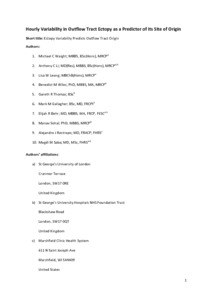Waight, MC; Li, AC; Leung, LW; Wiles, BM; Thomas, GR; Gallagher, MM; Behr, ER; Sohal, M; Restrepo, AJ; Saba, MM
(2022)
Hourly variability in outflow tract ectopy as a predictor of its site of origin.
J Cardiovasc Electrophysiol, 33 (1).
pp. 7-16.
ISSN 1540-8167
https://doi.org/10.1111/jce.15295
SGUL Authors: Behr, Elijah Raphael Saba, Magdi Mohamed Waight, Michael Charles Staward
![[img]](https://openaccess.sgul.ac.uk/113888/1.hassmallThumbnailVersion/OTVA%20paper%20-%20for%20SORA.pdf)  Preview |
|
PDF
Accepted Version
Available under License ["licenses_description_publisher" not defined].
Download (14MB)
| Preview
|
Abstract
INTRODUCTION: Before ablation, predicting the site of origin (SOO) of outflow tract ventricular arrhythmia (OTVA), can inform patient consent and facilitate appropriate procedural planning. We set out to determine if OTVA variability can accurately predict SOO. METHODS: Consecutive patients with a clear SOO identified at OTVA ablation had their prior 24-h ambulatory ECGs retrospectively analysed (derivation cohort). Percentage ventricular ectopic (VE) burden, hourly VE values, episodes of trigeminy/bigeminy, and the variability in these parameters were evaluated for their ability to distinguish right from left-sided SOO. Effective parameters were then prospectively tested on a validation cohort of consecutive patients undergoing their first OTVA ablation. RESULTS: High VE variability (coefficient of variation ≥0.7) and the presence of any hour with <50 VE, were found to accurately predict RVOT SOO in a derivation cohort of 40 patients. In a validation cohort of 29 patients, the correct SOO was prospectively identified in 23/29 patients (79.3%) using CoV, and 26/29 patients (89.7%) using VE < 50. Including current ECG algorithms, VE < 50 had the highest Youden Index (78), the highest positive predictive value (95.0%) and the highest negative predictive value (77.8%). CONCLUSION: VE variability and the presence of a single hour where VE < 50 can be used to accurately predict SOO in patients with OTVA. Accuracy of these parameters compares favorably to existing ECG algorithms.
| Item Type: |
Article
|
| Additional Information: |
This is the peer reviewed version of the following article: Waight, MC, Li, AC, Leung, LW, et al. Hourly variability in outflow tract ectopy as a predictor of its site of origin. J Cardiovasc Electrophysiol. 2022; 33: 7- 16, which has been published in final form at https://doi.org/10.1111/jce.15295. This article may be used for non-commercial purposes in accordance with Wiley Terms and Conditions for Use of Self-Archived Versions. This article may not be enhanced, enriched or otherwise transformed into a derivative work, without express permission from Wiley or by statutory rights under applicable legislation. Copyright notices must not be removed, obscured or modified. The article must be linked to Wiley’s version of record on Wiley Online Library and any embedding, framing or otherwise making available the article or pages thereof by third parties from platforms, services and websites other than Wiley Online Library must be prohibited. |
| Keywords: |
LVOT (left ventricular outflow tract) ectopy, RVOT (right ventricular outflow tract) ectopy, outflow tract ventricular arrhythmia, radiofrequency ablation, LVOT (left ventricular outflow tract) ectopy, outflow tract ventricular arrhythmia, radiofrequency ablation, RVOT (right ventricular outflow tract) ectopy, LVOT (left ventricular outflow tract) ectopy, RVOT (right ventricular outflow tract) ectopy, outflow tract ventricular arrhythmia, radiofrequency ablation, Cardiovascular System & Hematology, 1102 Cardiorespiratory Medicine and Haematology |
| SGUL Research Institute / Research Centre: |
Academic Structure > Molecular and Clinical Sciences Research Institute (MCS) |
| Journal or Publication Title: |
J Cardiovasc Electrophysiol |
| ISSN: |
1540-8167 |
| Language: |
eng |
| Dates: |
| Date | Event |
|---|
| 7 January 2022 | Published | | 25 November 2021 | Published Online | | 16 October 2021 | Accepted |
|
| Publisher License: |
Publisher's own licence |
| Projects: |
| Project ID | Funder | Funder ID |
|---|
| RES 20 21 001 | The Advanced Ventricular Arrhythmia Training and Research program | UNSPECIFIED |
|
| PubMed ID: |
34797600 |
| Web of Science ID: |
WOS:000722293400001 |
 |
Go to PubMed abstract |
| URI: |
https://openaccess.sgul.ac.uk/id/eprint/113888 |
| Publisher's version: |
https://doi.org/10.1111/jce.15295 |
Statistics
Item downloaded times since 05 Jan 2022.
Actions (login required)
 |
Edit Item |



